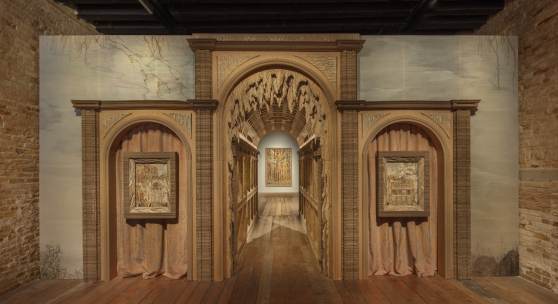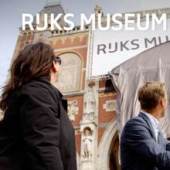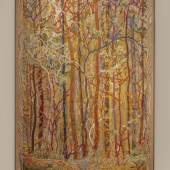Eva Jospin Selva Museo Fortuny
-
Ausstellung10.04.2024 - 24.11.2024
Curated by Chiara Squarcina e Pier Paolo Pancotto In collaboration with Galleria Continua
Eva Jospin's (Paris, 1975) work has always been inspired by nature in all its semantic and visual articulations. Through the use of materials such as cardboard, plant elements and fibres, metal parts, and fabric, the artist gives life to three-dimensional compositions, some of which very large and of a strong scenographic impact. Her works are imbued with a fairy-tale tone, and are at times mysterious, almost magical, evoking or recreating a world that is at the centre of her interests: landscapes, trees, plants, branches, leaves, geological formations, pieces of vegetation, architectural structures that induce reflection on various themes such as creativity and the operational and intellectual processes through which this is expressed, today as in the past. The project at the Museo Fortuny in Venice represents this once again: the works, imagined for the occasion, form a dialogue not only with the historical and environmental context that hosts them, Palazzo Pesaro degli Orfei, but above all with the identity of the collections the house contains: the artistic production of Mariano Fortuny.
This dialogue allows unexpected aesthetic and operational affinities to emerge between the poetics of the two interpreters: a continuous comparison and cross-reference between Jospin and Fortuny on nature, on creative and experimental processes, which find their maximum expression both in the conception and research into textiles, and in the study of artifice and scenic fiction, always linked to the world of theatre, constantly reflecting on the themes of perspective, proportions and the visual and emotional relationship between artistic creation and the spectator.
The large installation in the portego of Museo Fortuny is an artificial 'forest' that, once crossed, gives the sensation of losing all sense of time and space, of finding oneself in an undefined and disorienting 'elsewhere'.
The centrepiece of the installation is Galleria (2021-2024): an arched passageway with a coffered ceiling made of cardboard, wood and various materials in which various sources of inspiration from the artist's work recur. Some of these derive from her travels in Italy, and include details of Renaissance and Baroque architecture, classical architecture, capriccios, ruins and fountains, patrician villas and historical residences, religious buildings, and even works in museums. Inside the structure, as though reconstituting a Renaissance studiolo, there is a sequence of wood, cardboard and collage panels alternating with drawings depicting views that, while referring to elements of everyday life, evoke a distant, fairy-tale, almost mystical world like that of Symbolist and Nabis atmospheres.
At the ends of the corridor there are two plastic compositions that form its double entrance. The first, also called Galleria (2021-2024), reproduces a section of forest almost life-size and made even more credible by the brown colours of the wood and cellulose fibre that give it texture. The second, Nymphées (2022-2024), constitutes the artist's homage to the Venetian architectural tradition from the sixteenth century onwards: a serlian window comprising a central arched opening and two lateral openings with entablature from which two framed embroideries are hung, superimposed, in turn, on other embroideries, adopting a display mode that also appears in the layout of Mariano Fortuny's atelier on the museum's upper floor. Enclosed on the sides by two panels, the trompe-l'oeil paintings of rural subjects echo those executed by Fortuny in the 'winter garden' on the first floor of the house.
From the end of the portego visitors come to a room which, flanked by some ink studies for the two larger embroideries, contains Carmontelle (2023), an 'animated' panorama inspired by the transparent landscapes conceived by Louis Carrogis de Carmontelle (Paris 1717-1806): views engraved on canvas and rotated on a roll of paper stretched between two cylindrical structures used as a backdrop for stage and theatre performances. In like manner, Jospin elaborates a pierced view moved by a mechanical device that ideally recalls those conceived by the eighteenth-century French painter and architect in both structure and scenic function and, at the same time, recalls Fortuny's work in the field of stage design.
Visitors are invited to lose and find themselves in an ‘other’ dimension of the forest, one able to arouse pure wonder. This great allegory encloses a dense and multifaceted set of emotional states and reflects various levels of the sensorial and intellectual dimension of the individual, from amazement to amusement, from surprise to a sense of bewilderment and fear; states in which everyone can find themselves.
-
20.04.2024 - 24.11.2024Launched the second edition of Biennale College Arte For young emerging artists under 30 Venezia...
-
11.05.2018 - 24.11.2018Statement Gernot Blümel Bundesminister für EU, Kunst, Kultur und Medien Seit über 120 Jahren ist...
-
11.05.2019 - 24.11.2019Statement Gernot Blümel Bundesminister für EU, Kunst, Kultur und Medien Seit über 120 Jahren ist...
-
Permanent collection The core mission of the museum is to present the personal collection of...
-
1523 wurde Andrea Gritti Doge von Venedig. Er war ehrgeizig und sein Ziel war es, Venedig zur...
-
10.04.2024 - 24.11.2024
9.00 – 18.00 (last entrance at 17.00) from 01/04/2023 to 18/06/2023 9.00 – 19.00 (last entrance at 18.00)

















